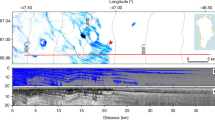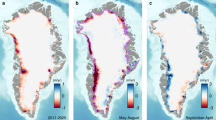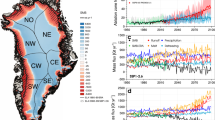Abstract
At high elevations of ice sheets, melting snow generally percolates and refreezes, so does not contribute to the shrinking of the ice sheet. Here, we systematically map the runoff area of the Greenland ice sheet using surface rivers visible on satellite imagery. Between 1985 and 2020, the maximum runoff elevation rose by 58–329 metres, expanding the runoff area by 29% (–8%/+6%). Excess melt beyond the refreezing capacity of pores in snowfall has created near-impermeable ice slabs that sustain surface runoff even in cooler summers. We show that two surface mass balance models over-estimate the runoff area by 16–30%. Once restricted to our observed areas, they indicate that 5–10% of recent runoff probably comes from the expanded runoff area. Runoff from higher elevations is sensitive to projected warming as further increases in the runoff limit will increase the runoff area disproportionately.
This is a preview of subscription content, access via your institution
Access options
Access Nature and 54 other Nature Portfolio journals
Get Nature+, our best-value online-access subscription
$29.99 / 30 days
cancel any time
Subscribe to this journal
Receive 12 print issues and online access
$209.00 per year
only $17.42 per issue
Buy this article
- Purchase on Springer Link
- Instant access to full article PDF
Prices may be subject to local taxes which are calculated during checkout



Similar content being viewed by others
Data availability
All Landsat Level-1 images used in this study are publicly available through the United States Geological Survey (https://landsat.usgs.gov) and via the Google Cloud Landsat dataset (https://cloud.google.com/storage/docs/public-datasets/landsat). MAR climate model outputs are available at the University of Liége (https://www.climato.uliege.be/cms/c_4471924/fr/climato-repertoire?uid=U204898/MARv3.11/Greenland/ERA_1958-2019-10km/daily_10km/). RACMO2.3p2 data are available from B. Noël (b.p.y.noel@uu.nl) upon request. Background land and ice areas are derived from NaturalEarth (https://www.naturalearthdata.com). Runoff-limit products and intermediary datasets are archived at https://doi.org/10.5281/zenodo.6472348. Source data are provided with this paper.
Code availability
Code developed to extract runoff limits from visible satellite imagery, and to produce all the results presented in this study, are available at https://doi.org/10.5281/zenodo.6472348.
References
Enderlin, E. M. et al. An improved mass budget for the Greenland ice sheet. Geophys. Res. Lett. 41, 866–872 (2014).
The IMBIE Team Mass balance of the Greenland ice sheet from 1992 to 2018. Nature, 579, 233–239 (2019).
Aschwanden, A. et al. Contribution of the Greenland ice sheet to sea level over the next millennium. Sci. Adv. 5, eaav9396 (2019).
Box, J. E. et al. Greenland ice sheet albedo feedback: thermodynamics and atmospheric drivers. Cryosphere 6, 821–839 (2012).
Fausto, R. S. The Greenland ice sheet—snowline elevations at the end of the melt seasons from 2000 to 2017. Geol. Surv. Den. Greenl. Bull. 41, 71–74 (2018).
Harper, J., Humphrey, N., Pfeffer, W. T., Brown, J. & Fettweis, X. Greenland ice-sheet contribution to sea-level rise buffered by meltwater storage in firn. Nature 491, 240–243 (2012).
Pfeffer, W. T., Meier, M. F. & Illangasekare, T. H. Retention of Greenland runoff by refreezing: implications for projected future sea level change. J. Geophys. Res. 96, 22117 (1991).
Braithwaite, R. J., Laternser, M. & Pfeffer, W. T. Variations of near-surface firn density in the lower accumulation area of the Greenland ice sheet, Pakitsoq, West Greenland. J. Glaciol. 40, 477–485 (1994).
Parry, V. et al. Investigations of meltwater refreezing and density variations in the snowpack and firn within the percolation zone of the Greenland ice sheet. Ann. Glaciol. 46, 61–68 (2007).
Fettweis, X., Tedesco, M., van den Broeke, M. & Ettema, J. Melting trends over the Greenland ice sheet (1958–2009) from spaceborne microwave data and regional climate models. Cryosphere 5, 359–375 (2011).
Cogley, J. et al. Glossary of Glacier Mass Balance and Related Terms (UNESCO, 2011).
Nghiem, S. V. et al. The extreme melt across the Greenland ice sheet in 2012. Geophys. Res. Lett. 39, L20502 (2012).
Tedesco, M. & Fettweis, X. Unprecedented atmospheric conditions (1948–2019) drive the 2019 exceptional melting season over the Greenland ice sheet. Cryosphere 14, 1209–1223 (2019).
Machguth, H. et al. Greenland meltwater storage in firn limited by near-surface ice formation. Nat. Clim. Change 6, 390–393 (2016).
Miller, O. L. et al. Hydraulic conductivity of a firn aquifer in southeast Greenland. Front. Earth Sci. 5, 38 (2017).
Miller, O. et al. Direct evidence of meltwater flow within a firn aquifer in southeast Greenland. Geophys. Res. Lett. 45, 207–215 (2018).
Forster, R. et al. Extensive liquid meltwater storage in firn within the Greenland ice sheet. Nat. Geosci. 7, 95–98 (2014).
Miége, C. et al. Spatial extent and temporal variability of Greenland firn aquifers detected by ground and airborne radars. J. Geophys. Res. Earth Surf. 121, 2381–2398 (2016).
Brangers, I. et al. Sentinel-1 detects firn aquifers in the Greenland ice sheet.Geophys. Res. Lett. 47, e2019GL085192 (2020).
Humphrey, N. F., Harper, J. T. & Pfeffer, W. T. Thermal tracking of meltwater retention in Greenland’s accumulation area. J. Geophys. Res. Earth Surf. 117, F01010 (2012).
Culberg, R., Schroeder, D. M. & Chu, W. Extreme melt season ice layers reduce firn permeability across Greenland. Nat. Commun. 12, 2336 (2021).
van Angelen, J. H. et al. Rapid loss of firn pore space accelerates 21st century Greenland mass loss. Geophys. Res. Lett. 40, 2109–2113 (2013).
Brown, J., Harper, J., Pfeffer, W., Humphrey, N. & Bradford, J. High resolution study of layering within the percolation and soaked facies of the Greenland ice sheet. Ann. Glaciol. 52, 35–41 (2011).
de la Peña, S. et al. Changes in the firn structure of the western Greenland ice sheet caused by recent warming. Cryosphere 9, 1203–1211 (2015).
MacFerrin, M. et al. Rapid expansion of Greenland‘s low-permeability ice slabs. Nature 573, 403–407 (2019).
Gleason, C. J. et al. Characterizing supraglacial meltwater channel hydraulics on the Greenland ice sheet from in situ observations. Earth Surf. Process. Landf. 41, 2111–2122 (2016).
Yang, K. & Smith, L. C. Internally drained catchments dominate supraglacial hydrology of the southwest Greenland ice sheet. J. Geophys. Res. 121, 1891–1910 (2016).
Yang, K. et al. River detection in remotely sensed imagery using Gabor filtering and path opening. Remote Sens. 7, 8770–8802 (2015).
Noël, B., van de Berg, W. J., Lhermitte, S. & van den Broeke, M. R. Rapid ablation zone expansion amplifies north Greenland mass loss. Sci. Adv. 5, eaaw0123 (2019).
Ahlstrøm, A. P., Petersen, D., Langen, P. L., Citterio, M. & Box, J. E. Abrupt shift in the observed runoff from the southwestern Greenland ice sheet. Sci. Adv. 3, e1701169 (2017).
Rennermalm, A. et al. Shallow firn cores 1989–2019 in southwest Greenland‘s percolation zone reveal decreasing density and ice layer thickness after 2012. J. Glaciol. https://doi.org/10.1017/jog.2021.102 (2021).
Colgan, W. et al. Initial field activities of the Camp Century Climate Monitoring Programme in Greenland. Geol. Surv. Den. Greenl. Bull. 41, 75–78 (2018).
Fettweis, X. et al. Reconstructions of the 1900–2015 Greenland ice sheet surface mass balance using the regional climate MAR model. Cryosphere 11, 1015–1033 (2017).
Fettweis, X. et al. GrSMBMIP: intercomparison of the modelled 1980–2012 surface mass balance over the Greenland ice sheet. Cryosphere 14, 3935–3958 (2020).
Fountain, A. G. The storage of water in, and hydraulic characteristics of, the firn of South Cascade Glacier, Washington State, USA. Ann. Glaciol. 13, 69–75 (1989).
van As, D. & Mikkelsen, A. et al. Hypsometric amplification and routing moderation of Greenland ice sheet meltwater release. Cryosphere 11, 1371–1386 (2017).
Howat, I. M., Negrete, A. & Smith, B. E. The Greenland Ice Mapping Project (GIMP) land classification and surface elevation data sets. Cryosphere 8, 1509–1518 (2014).
Moussavi, M. S. et al. Derivation and validation of supraglacial lake volumes on the Greenland ice sheet from high-resolution satellite imagery. Remote Sens. Environ. 183, 294–303 (2016).
Gillies, S. et al. Rasterio: geospatial raster I/O for Python programmers (Map-box, 2013); https://github.com/rasterio/rasterio
Langen, P. L., Fausto, R. S., Vandecrux, B., Mottram, R. H. & Box, J. E. Liquid water flow and retention on the Greenland ice sheet in the regional climate model HIRHAM5: local and large-scale impacts. Front. Earth Sci. 4, 110 (2017).
Hersbach, H. et al. The ERA5 global reanalysis. Q. J. R. Meteorol. Soc. 146, 1999–2049 (2020).
Dee, D. P. et al. The ERA-Interim reanalysis: configuration and performance of the data assimilation system. Q. J. R. Meteorol. Soc. 137, 553–597 (2011).
Colbeck, S. C. An overview of seasonal snow metamorphism. Rev. Geophys. 20, 45–61 (1982).
Meyer, C. R. & Hewitt, I. J. A continuum model for meltwater flow through compacting snow. Cryosphere 11, 2799–2813 (2017).
Snyder, J. P. Map Projections: A Working Manual (USGS, 1987).
Tedesco, M. et al. Evidence and analysis of 2012 Greenland records from spaceborne observations, a regional climate model and reanalysis data. Cryosphere 7, 615–630 (2013).
Acknowledgements
This work was funded under the European Research Council award 818994—CASSANDRA (A.J.T. and H.M.). In addition to the authors, the project team comprises N. Clerx and N. Jullien. P. Bednawrek (University of Fribourg) provided computational support.
Author information
Authors and Affiliations
Contributions
A.J.T. and H.M. designed the study. A.J.T. processed and analysed the data and wrote the manuscript with input from H.M. Both authors contributed to the interpretation of the results.
Corresponding author
Ethics declarations
Competing interests
The authors declare no competing interests.
Peer review
Peer review information
Nature Climate Change thanks Shawn Marshall, Luke Trusel and the other, anonymous, reviewer(s) for their contribution to the peer review of this work.
Additional information
Publisher’s note Springer Nature remains neutral with regard to jurisdictional claims in published maps and institutional affiliations.
Extended data
Extended Data Fig. 1 Extraction of hydrological features from Landsat images.
The sequence of principal image processing steps which are undertaken to identify and extract hydrological features, shown here for a region of a Landsat 8 product acquired on 13 August 2019 (LC08_L1TP_006013_20190813_20190820_01_T1; Extended Data Fig. 2e shows location). The names above each panel in the sequence correspond to those described in the Methods. Credit: USGS (landsat.usgs.gov).
Extended Data Fig. 2 Example runoff limit retrievals.
Individual runoff limit retrievals are shown in red, on top of their source Landsat near-infrared image. Inset map shows the location of each image. Landsat product identifiers are: a LT05_L1TP_020001_19950712_20180221_01_T1 (no retrievals); b LT05_L1TP_035003_19950705_20180221_01_T1; c LT05_L1GS_021006_19970809_20180221_01_T2; d LE07_L1TP_011010_20090812_20161218_01_T1; e LC08_L1TP_006013_20190813_20190820_01_T1; f LE07_L1TP_005015_20110808_20161207_01_T1. Credit: USGS (landsat.usgs.gov).
Extended Data Fig. 3 Aggregation of runoff limit retrievals.
a. All runoff limit retrievals made in SW-1 (see Fig. 1) during 2019. Land areas are shown in light grey and ice areas in white. Dotted lines show limit of SW-1 and the dark grey region shows the slice enlarged in panel c. Circles correspond to individual runoff limit retrievals, coloured by the 8 clusters identified in this box during 2019. b. Landsat product LC08_L1TP_006013_20190813_20190820_01_T1 (Extended Data Fig. 2e) with detected runoff limit positions (orange circles), which belong to the orange cluster in panel a. Also shown is the median runoff limit during 2019 (dashed line), +/- 1 MAD (dotted lines). c. Inset of the middle slice (S) of SW-1, showing only the runoff limit retrievals within S. The median of the highest-elevation cluster (black circle) defines the annual runoff limit. The red circle shows the estimated maximum runoff limit in 2019 (see d,e). d. Density histogram of all runoff limit retrievals made in SW-1 during 2019 (colours correspond to the clusters in panels a and c, and saturation shows observation density). The runoff limit picked for S in panel c is shown by the black circle. e. The polynomial adjusted to intercept 2019’s runoff limit (black circle and in panel c) estimates that the maximum likely runoff limit was slightly higher (red circle and in panel c). Credit: USGS (landsat.usgs.gov).
Extended Data Fig. 4 Observation availability by elevation.
a–g, Counts (N) of the mean number of cloud-free observations made in each 100 m elevation bin of each region. Bins with more than 10 observations are shaded dark blue. Orange crosses indicate the runoff limit at 100 m resolution.
Extended Data Fig. 5 Comparison between observed and maximum likely runoff limits.
Left Annual box plots for each region show the difference between observed and maximum likely runoff limits. Each boxplot depicts the differences for all 1 km slices which compose the region. Medians are denoted by black horizontal lines and the inter-quartile range (IQ = Q3 - Q1) by the coloured box. Whiskers correspond to Q1 - 1.5IQ and Q3 + 1.5IQ. All differences are positive, that is the estimated maximum is always equal to or higher than the observed runoff limit. Right Polynomial curves describing the seasonal relative elevation (metres) in each region. Background shading shows relative density of the data (in 20 m bins) to which each curve was fitted. d, right Two curves are shown. The dashed curve is fitted to all data. The solid curve is fitted only to data before day 230 and is used to derive the differences shown in the box-plots.
Extended Data Fig. 6 Break-year identification statistics.
a,b, Two-tailed D’Agostino’s K2 test for normality. p > 0.05 indicates that the null hypothesis H0, that the data are drawn from a normal distribution, cannot be rejected. a. K2 values for the part of the time series before the specified break date. b. K2 values for the part of the time series after the specified break date. c. Two-tailed t-test of whether each runoff limit time series can be separated into early versus late periods by the specified break-year. p < 0.01 indicates that the break-year is significant. Each chosen break-year has the largest T-statistic at p < 0.01, and the early and late periods can be considered normal (as panels a and b show that H0 could not be rejected).
Extended Data Fig. 7 Correspondence of visible runoff limits with ice slab locations.
1985-1992 (blue) and 2013-2020 (pink) runoff areas overlaid with ice slab locations (black outlines) mapped by MacFerrin et al. 25 using airborne Accumulation Radar. Grey lines show the flight lines of the Operation IceBridge flights on which the Accumulation Radar was flown.
Extended Data Fig. 8 Estimates of runoff area from regional climate models.
The sensitivity of modelled runoff area depending on the chosen threshold value above which annual runoff contributes to runoff area, over the range 1 to 20 mm w.e. a-1. Results in the main text use 10 mm w.e. a-1. a,c Estimates for MAR. b,d Estimates for RACMO. a,b Runoff area at each threshold. c,d For the threshold values 5, 10 and 20 mm w.e. a-1, the percentage difference to the area calculated at the 1 mm w.e. a-1 threshold.
Extended Data Fig. 9 Regional estimates of modelled runoff area and volume.
Regions are colour-coded according to Fig. 1. Upper panels: Correspondence between observed and modelled runoff area. Values > 100% indicate that the modelled area is larger than the observed area. Lower panels: Annual runoff volume (gigatonnes, Gt) from RACMO (dashed lines) and MAR (solid lines), (i) from above the 1985–1992 limit up to that year’s limit (black lines) and (ii) integrating all modelled runoff occurring above the 1985–1992 limit (grey lines). Vertical bars indicate +/- 1MAD.
Source data
Source Data 1
Annual runoff-limit elevation (metres) at 100 km spacing and for each region.
Source Data 2
Annual relative runoff-limit elevation (metres), annual excess melt and 10-year average excess melt, together with break-point year, for each region.
Source Data 3
Size of the RACMO and MAR runoff areas above the observed 1985–1992 runoff limit (square km); runoff volumes above the 1985–1992 limit from each model ±1 median absolute deviation, divided by region.
Rights and permissions
About this article
Cite this article
Tedstone, A.J., Machguth, H. Increasing surface runoff from Greenland’s firn areas. Nat. Clim. Chang. 12, 672–676 (2022). https://doi.org/10.1038/s41558-022-01371-z
Received:
Accepted:
Published:
Issue Date:
DOI: https://doi.org/10.1038/s41558-022-01371-z
This article is cited by
-
Firn on ice sheets
Nature Reviews Earth & Environment (2024)
-
Short- and long-term variability of the Antarctic and Greenland ice sheets
Nature Reviews Earth & Environment (2024)



